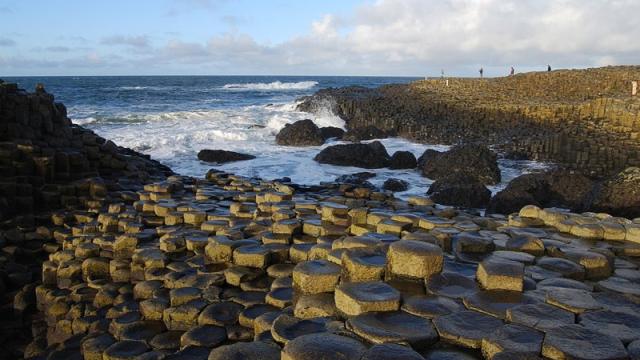Visitors to the coast of Northern Ireland have always marveled at the so-called Giant’s Causeway — a field of some 40,000 interlocking basalt columns arranged in a tidy hexagonal pattern. German physicists have devised a new model to help explain just how those neat geometric patterns emerge through natural processes.
Sir Richard Bulkeley, then the bishop of Derry, announced his “discovery” of the Giant’s Causeway to the Royal Society of London in 1692. This sparked a lively debate about just how the causeway may have formed. My personal favourite, courtesy of Irish legend, is that it was built by a Northern Ireland giant named Finn McCool, the better to taunt a Scottish rival — hence the name Giant’s Causeway.
Scientists were inclined to search for less mythical explanations, reasoning that perhaps ordinary men had built the causeway, armed with pick and chisels. In 1771, a French scientist named Demarest suggested volcanic activity might be the culprit, and this remains the accepted explanation. Those columnar joints were formed some 60 million years ago, as molten lava from a massive eruption flowed into the sea, cooling rapidly and shrinking into the hexagonal columns.
Back in 2007, University of Toronto physicist Stephen Morris and his then-graduate student, Lucas Goehring elaborated on that basic mechanism. “The columns are formed as a sharp front of cooling moves into the lass flow, assisted by the boiling of groundwater,” Goehring explained at the time. “As the front advances, it leaves behind a crack network which evolves into an almost hexagonal arrangement. This network carves out the columns.”
They even managed to create similar hexagonal patterns using corn starch and water mixed into a coffee cup. After shining a light over the cup for a week or so, the mixture had dried completely. When they broke it apart, they found “starch columns” had formed in the interior. They used X-ray tomography to reveal this pattern in unprecedented detail:
In a paper published earlier this month in Physical Review Letters, Martin Hofmann of the Dresden Technical University and several German colleagues described a new model to explain how those striking hexagonal patterns formed, building on Morris and Goehring’s earlier work (and that of other scientists as well). Specifically, they were interesting in why crack patterns can start out looking rectangular on the surface, but evolve into a hexagonal pattern as the cracks spread from the top down. Per the synopsis:
They found that, in the initial stages of cooling, when the cracks start to appear at random places on the surface, the energy release is greatest if the cracks intersect at 90-degree angles. This transition from individual to collective growth of the cracks drives the pattern from rectangular to hexagonal. The hexagonal pattern is then maintained as the lava cools further, eventually leading to an array of hexagonal columns, simiar to those seen in nature.
Morris pronounced their findings “a nice result” but emphasised that it is far from the final word on the subject. He explained to Gizmodo via email that the German scientists’ conclusions rest on one big starting assumption: that the cracks “will move in such a way as to maximise the release rate of the elastic energy.” Given that optimising principle, hexagons are indeed the best pattern to accomplish that. “But fracture mechanics is just not that simple,” said Morris. “It presents a new calculation that answers some questions, but can’t handle other aspects of the problem. And that’s OK!”
For instance, he and Goehring examined what mechanism might be involved in selecting the size of the columns. They found that it depends on how fast the cracks propagate, and the rate at which water can move through the starch. However, “This [latest] paper does not address that problem because it does not allow cracks to stop, which causes the merger of two columns,” he said.
Morris and Goehring’s earlier work also looked at how the arrays of columns evolved into a partial randomness — the columns aren’t quite as perfectly hexagonal as previously believed. In contrast, the Hoffmann et al paper assumes a “spherical cow” from the outset: perfectly regular, brick-like patterns of cracks that turn into perfectly hexagonal columns. As such, it does not attempt to explain the disorder observed in basalt columns found in nature. Nor does it explain the existence of what Morris calls “wavy” columns. “Some locations have columns that oscillate in their diameters as they form,” he said.
As for why the precise mechanisms behind the basalt columns of Giant’s Causeway and similar geologic structures continue to intrigue physicists, “Anything that Nature does that creates ordered structures is inherently interesting,” said Morris. “If Nature were not so creative, we would not be here to appreciate her creativity.”
References:
Goehring, L., Lin, Z., and Morris, S.W. (2006) “An experimental investigation of the scaling of columnar joints,” Physical Review E 74: 036115.
Goehring, L. and Morris, S.W. (2008) “The scaling of columnar joints in basalt,” Journal of Geophysical Research 113: B10203.
Goehring, L. and Morris, S.W. (2014) “Cracking mud, freezing dirt, and breaking rocks,” Physics Today 67(11): 45.
Hoffmann, Martin et al. (2015) “Why hexagonal basalt columns?” Physical Review Letters 115: 154301.
Image: Chmee2/Wikimedia Commons.
